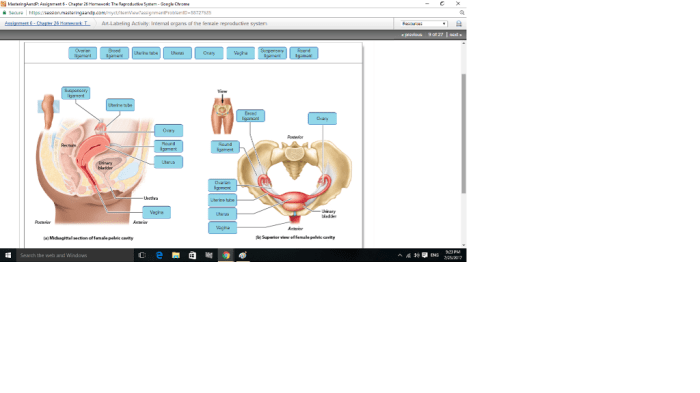Art-labeling activity internal organs of the female reproductive system – Introducing the art-labeling activity on the internal organs of the female reproductive system, an engaging and effective pedagogical tool that empowers students to grasp the intricacies of this vital system. Through the meticulous labeling of anatomical structures, learners embark on a journey of discovery, enhancing their understanding and appreciation of the female body.
This activity seamlessly integrates art and science, fostering visual literacy and deepening conceptual knowledge. By actively engaging with labeled and unlabeled diagrams, students develop a comprehensive understanding of the ovaries, fallopian tubes, and uterus, unraveling their functions and significance within the reproductive system.
Internal Organs of the Female Reproductive System
The female reproductive system consists of several internal organs that work together to facilitate reproduction. These organs include the ovaries, fallopian tubes, uterus, and cervix.
The ovaries are responsible for producing and releasing eggs. They also produce hormones that regulate the menstrual cycle. The fallopian tubes transport the eggs from the ovaries to the uterus. The uterus is where the fertilized egg implants and develops into a fetus.
The cervix is the lower part of the uterus that connects to the vagina.
Ovaries, Art-labeling activity internal organs of the female reproductive system
- Produce and release eggs
- Produce hormones that regulate the menstrual cycle
Fallopian Tubes
- Transport eggs from the ovaries to the uterus
- Provide a site for fertilization
Uterus
- Where the fertilized egg implants and develops into a fetus
- Consists of three layers: the endometrium, myometrium, and perimetrium
- The endometrium is the innermost layer and is responsible for implantation
- The myometrium is the middle layer and is responsible for contractions
- The perimetrium is the outermost layer and is responsible for protection
Art-Labeling Activity Design

An art-labeling activity is a great way for students to learn about the anatomy of the female reproductive system. This activity can be used as a pre-lab exercise, a review activity, or an assessment.
To create an art-labeling activity, you will need:
- A diagram of the female reproductive system
- A list of labels for the organs of the female reproductive system
- Paper
- Pencils or crayons
To complete the activity, students will:
- Label the organs of the female reproductive system on the diagram
- Color the diagram
Classroom Implementation: Art-labeling Activity Internal Organs Of The Female Reproductive System

The art-labeling activity can be incorporated into a lesson plan in a variety of ways. For example, you could use the activity as a pre-lab exercise to introduce students to the anatomy of the female reproductive system. You could also use the activity as a review activity after students have learned about the female reproductive system.
Finally, you could use the activity as an assessment to assess students’ understanding of the female reproductive system.
To assess student understanding, you could have students complete the activity individually or in pairs. You could also have students present their labeled diagrams to the class. Additionally, you could have students write a short paragraph describing the anatomy of the female reproductive system.
The art-labeling activity can be extended to include additional topics or activities. For example, you could have students research the functions of the different organs of the female reproductive system. You could also have students create a model of the female reproductive system.
Educational Benefits

The art-labeling activity can enhance students’ understanding of the female reproductive system in a number of ways. First, the activity helps students to visualize the anatomy of the female reproductive system. Second, the activity helps students to learn the names of the different organs of the female reproductive system.
Third, the activity helps students to understand the functions of the different organs of the female reproductive system.
The use of visual aids in science education can be very effective. Visual aids can help students to understand complex concepts more easily. They can also help students to remember information more effectively.
There is a large body of research that supports the effectiveness of art-labeling activities. For example, one study found that students who participated in an art-labeling activity were able to identify more organs of the female reproductive system than students who did not participate in the activity.
FAQ Summary
What are the benefits of using art-labeling activities in science education?
Art-labeling activities offer numerous benefits, including enhanced visual literacy, improved memory and recall, increased engagement, and deeper conceptual understanding.
How can I incorporate the art-labeling activity into my lesson plan?
Incorporate the activity as a hands-on learning experience, a review tool, or an assessment to gauge student understanding. Encourage group work and discussions to foster collaboration and knowledge sharing.
What evidence supports the effectiveness of art-labeling activities?
Research studies have demonstrated that art-labeling activities can significantly improve student learning outcomes, particularly in science education. They promote active learning, enhance visual memory, and facilitate deeper understanding of complex concepts.